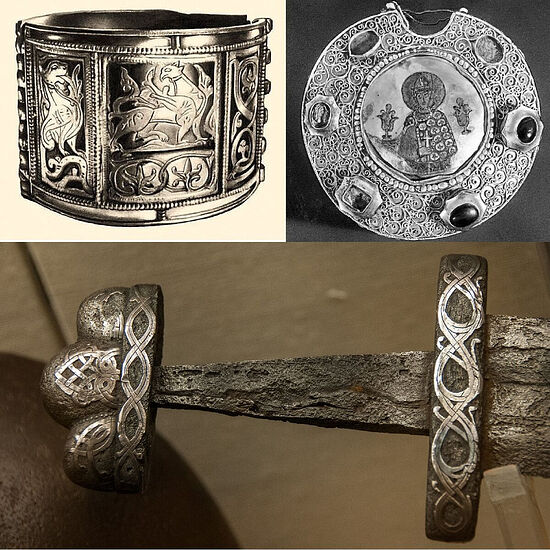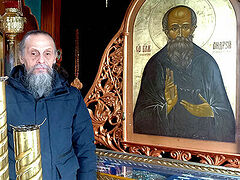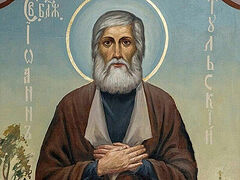In the year 2024, the ancient Russian city of Toropets officially celebrates its 950th anniversary. There will be events scheduled to celebrate it throughout the year. And today, on the commemoration day of Isaac of Toropets, we publish a note about this saint, from whose hagiography it became known that Toropets existed since 1074, perhaps earlier.
Thou didst shine like a lamp,
from the city of Toropets, and even to Kiev,
Amazing the whole world with thy honorable life…
From the Akathist to St. Isaac, recluse of the Caves
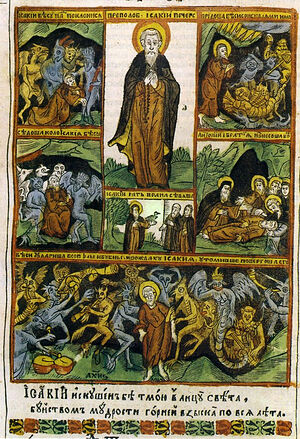 Venerable Isaac of Toropets. Kiev Caves Patericon. 1661 February 27 is the commemoration day of the remarkable saint, Venerable Isaac of Toropets. His hagiography was recounted to us by the most famous chronicler of Ancient Rus’, St. Nestor, who wrote:
Venerable Isaac of Toropets. Kiev Caves Patericon. 1661 February 27 is the commemoration day of the remarkable saint, Venerable Isaac of Toropets. His hagiography was recounted to us by the most famous chronicler of Ancient Rus’, St. Nestor, who wrote:
“There was also another monk named Isaac; he was wealthy while living in the world, for he was a merchant, a Toropets native born... and his secular name was Chern.”1
This passage in the “Primary Chronicle” is dated to the year 1074 (according to our calendar). The date of the first mention indicates that Toropets is the oldest city in the entire Tver region.2
Although this date is accepted as the “official year of foundation,” it is clear that by this time Toropets was already a well-established medieval city. It is noteworthy that while St. Nestor often added geographical clarifications when mentioning other place names, in this case, he simply used the word “Toropets native.” This may suggest that during St. Nestor’s lifetime in Kiev, there was no need to explain who a Toropets native was – the city on the Toropa River was sufficiently known to those living on the banks of the Dnieper.
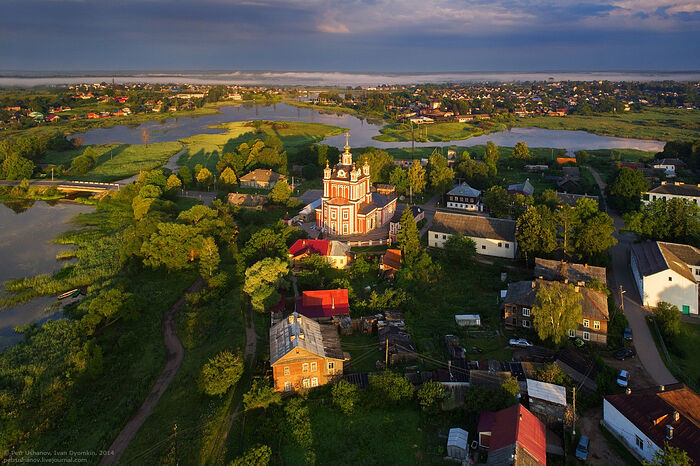 Toropets. Photo: Zelengarden.ru
Toropets. Photo: Zelengarden.ru
This prominence can be explained by advanced trade connections. Let us remember that Isaac was a merchant in the secular world (and a wealthy one at that!). Toropets stood on the route “from the Varangians to the Greeks”.3
In the book, Ancient Toropets. Archaeological Excavations, a theory is suggested that it was the princes of Kiev, interested in establishing control over the waterway to Novgorod, who “built the powerful fortifications of the Small Settlement (Toropets), and stationed a military detachment here.”4
The name Toropets was likely derived from the river on which it stood. This version is confirmed by the renowned specialist in Russian toponymy, the author of the book, Names of Ancient Russian Cities, Doctor of Philological Sciences Vladimir Petrovich Neroznak.5
As for St. Isaac’s secular name, Chern [Russian for “black”], it may indicate that a wealthy merchant could emerge from the common classes—the “black folk.”6
“Chern” was also the name of a very expensive type of artistic metal engraving.
“In the twelfth to thirteenth centuries, Suzdal craftsmen made lightweight steel axes with engraved blades, decorated with gold and chern; they were worn at the belt by noble warriors.”7
Parents could name a child Chern for a special shade of hair. This version is the most likely. In chronicles and birch bark documents, personal names based on hair color often appear: Chernysh, Chernyay, Chernyava, Bel, Belyay, Belyak, Belukha [White]...8 The familiar Christian names we all know today became commonplace several centuries later.
So, the wealthy merchant, “a native of Toropets,” sets off to Kiev, presumably on business matters.
When the phrase “ancient Russian city” is mentioned, a contemporary often associates it with Pushkin’s lines:
“Brightly shine the cupolas of churches,
And of holy monasteries...”9
In reality, such splendor did not exist in Kiev in St. Isaac’s times. St. Anthony of the Caves had only just founded the first Russian monastery—the future Kiev Caves Lavra.
We can only speculate on the path of the merchant Chern and what struck his soul.
Perhaps, having settled all his affairs, he decided to visit the Desyatynna Church in Kiev and attended the reading of the Gospel:
One thing thou lackest: go thy way, sell whatsoever thou hast, and give to the poor, and thou shalt have treasure in heaven: and come, take up the cross, and follow me (Mk. 10:21).
St. Nestor the Chronicler describes what happened:
“And he decided to become a monk, and distributed his wealth to the needy and to the monasteries, and went to the great Anthony in the cave, asking to be tonsured as a monk. And Anthony received him, and gave him the monastic garment, and gave him the name Isaac...”10
From this moment begins the path of spiritual ascent, which is neither easy nor smooth. The former merchant underwent many trials. For seven years, he confined himself “in a small cell, four cubits in size... without going out into the light.”11
Despite the warnings of his spiritual father, Elder Anthony,
“Isaac led a strict life... He prayed to God with tears. His only food was prosphora, and that only every other day, and he drank water in moderation... When he grew tired, he sat on his chair, never lying on his side, but sleeping a little while sitting...”12
After seven years of such ascetic labors, Isaac’s cave was once filled with unearthly light. Two angels appeared before him, and said, “Isaac, you have pleased God! Behold, Christ is coming to you – bow down to him!”
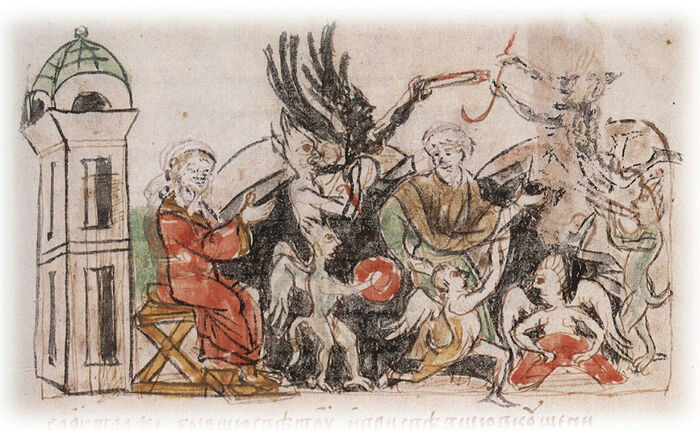 Demonic cavorting in St. Isaac’s cell. Miniature from the Radzivillov Chronicles, late 15th c.
Demonic cavorting in St. Isaac’s cell. Miniature from the Radzivillov Chronicles, late 15th c.
The dazed, Isaac, without even making the sign of the cross, obeyed the command... The “bright angels” took on the appearance of demons and shouted:
“You bowed to us, now you are ours!”13
This event is described in the akathist to the Venerable Isaac:
“The dark enemy appeared in the guise of light, obscuring you with ignorance, troubling you with songs and dances, frightening you with beatings, wounds, and ringing in the ears, leaving you barely alive. But you, O venerable one, remained firm and unshaken. Strengthened by the prayers of the Cave saints, you firmly resisted all the enemy’s cunning...”14
Exhausted by the demons, Isaac could neither walk, speak, nor eat... For several years, the holy fathers Anthony and Theodosius cared for the weakened monk.
Having tormented the body, the devil could not take away the prayers of the saint, and eventually strength returned to Isaac. For enduring trials with steadfastness, sincere prayer, and feats, he received the gift of miracles.
“And the brotherhood began to honor him. But not desiring human glory, he began to act as a fool and play pranks on the abbot, the brethren, and even laymen, so that some even beat him. And he started wandering around, acting like a fool...”15
Foolishness for Christ is a particular form of sanctity where spiritual gifts and virtues are consciously hidden behind external, ostensible madness. Holy fools, or, as they were also called, “blessed for Christ’s sake,” performed many miracles and typically walked around in rags and barefoot regardless of the season.
So did Isaac.
Coming to Matins earlier than everyone else, he stood firm and immovable. When severe winter frost set in, he stood in boots with worn-out soles, so that his feet froze to the stone, and he did not move his feet until Matins was over. Then he went to the kitchen and prepared fire, water, and firewood...”16
The first holy fools appeared in Byzantium, but this form of sanctity truly flourished in Russia, where holy fools were especially beloved. Such a person could say anything, even to the Tsar.
It was Isaac of Toropets who became the first Russian fool for Christ!
Describing the miraculous events that occurred with Isaac, the Chronicler Nestor testifies: “I myself was an eyewitness to other events.”17
St. Nestor’s attitude toward Isaac is evident from the fact that in the Primary Chronicle, Isaac of Toropets is allotted four chapters, whereas many other people, even Grand Princes, are only given a couple of lines!
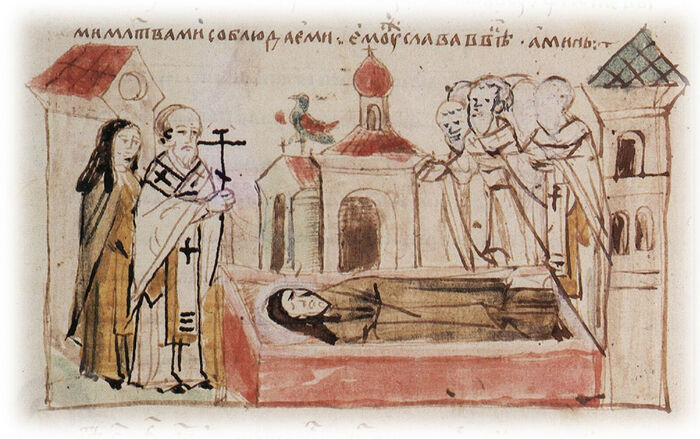 The funeral of St. Isaac, served by Abbot John and brothers. Miniature from the Radzivillov Chronicle, late fifteenth c.
The funeral of St. Isaac, served by Abbot John and brothers. Miniature from the Radzivillov Chronicle, late fifteenth c.
A monastic saint, a recluse, a fool for Christ – Isaac was a bearer of so many forms of sanctity. For his humility and ascetic labors, the Lord endowed His chosen one with special gifts. In the akathist to St. Isaac, he is called “a quick helper and a glorious wonderworker.”18
In 2015, in the village of Stary Toropa (near Toropets), a church was consecrated in honor of the Venerable Isaac, recluse of the Caves. Parishioners recount numerous instances when, through prayer to Isaac of Toropets, difficult life circumstances were resolved, requests were granted, and unexpected help arrived. According to the testimony of a person who experienced a critical situation where a human life was saved, “Help came in a completely unexpected way, immediately after the fervent plea: ‘Saint Isaac, help!’”19
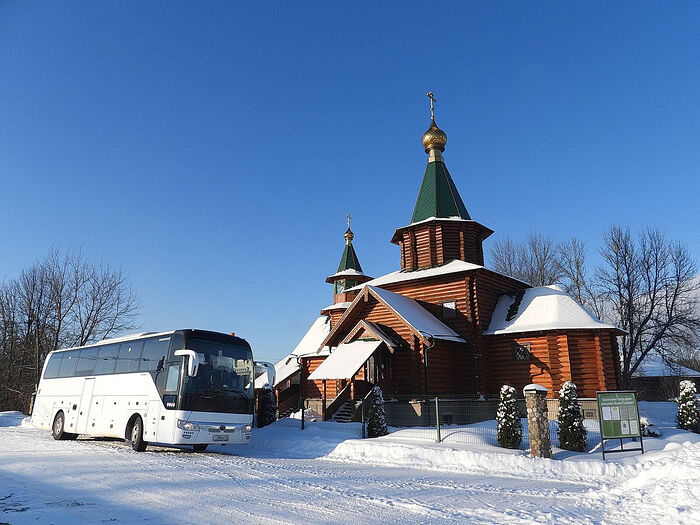 The Church of St. Isaac, Recluse of the Kiev Caves, in the village of Old Toropa.
The Church of St. Isaac, Recluse of the Kiev Caves, in the village of Old Toropa.
In the church in Old Toropa, there is an icon with a particle of the saint’s relics.
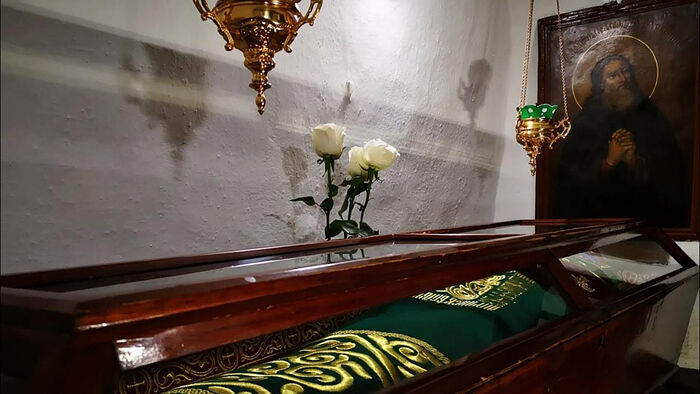 The relics of St. Isaac in the near Caves of the Kiev Cave Lavra.
The relics of St. Isaac in the near Caves of the Kiev Cave Lavra.
The relics of St. Isaac himself still reside in the Near Caves of the Kiev Caves Lavra to this day, alongside the relics of St. Nestor the Chronicler, who described his life, and the legendary hero, St. Ilya Muromets.
St. Isaac remains a special patron of his native land, the city of Toropets and the ancient Toropets land.

